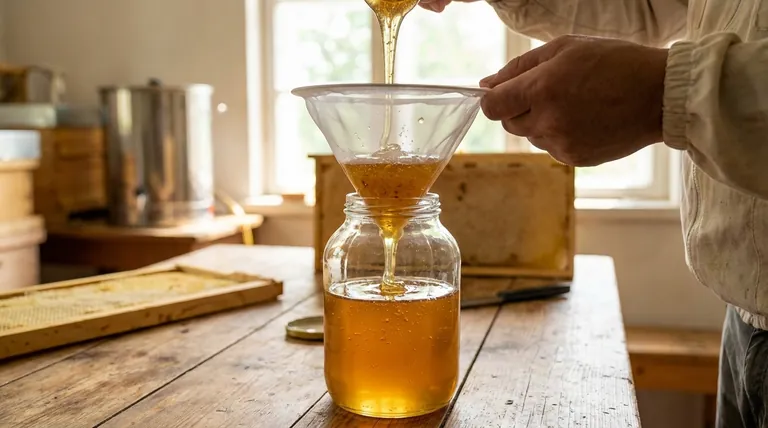At its core, using a honey filter is about quality control and market readiness. The primary benefits are the removal of physical impurities like wax and bee parts, the prevention of contamination during bottling, and the preservation of the honey's natural flavor and aroma, which are all critical for producing a safe and appealing final product.
The decision to filter honey is not just about cleanliness. It is a strategic choice that balances product purity against operational costs and the desired characteristics of your final product, directly impacting both efficiency and customer perception.

The Core Benefits of Honey Filtration
Filtration is a fundamental step in preparing raw honey for the consumer. It addresses key issues of safety, quality, and aesthetics that arise after extraction from the comb.
Ensuring Product Purity and Safety
Raw honey naturally contains particles you don't want in the final jar, such as bits of beeswax, wood from the frames, and even bee parts.
Filters act as a physical barrier, trapping these impurities. This process is crucial for preventing potential contamination and ensuring the honey is clean and safe for consumption.
Preserving Natural Flavor and Aroma
While the goal is to remove foreign matter, a proper filtration system is designed to do so without stripping the honey of its essential character.
By removing only the unwanted debris, the distinct and delicate flavor profiles and aromas unique to the honey's floral source are maintained and allowed to stand out. This is a vital factor in customer satisfaction and repeat business.
Enhancing Visual Appeal
Many consumers expect honey to be clear, golden, and free of specks. Filtration helps achieve this polished, professional appearance.
Removing suspended particles results in a visually clean product that looks more appealing on the shelf and aligns with market expectations for high-quality honey.
Operational and Economic Advantages
Beyond product quality, modern honey filters are designed with the producer's operational efficiency and budget in mind.
Economical and Efficient Operation
Many filter systems are engineered for economical operation, requiring minimal energy and time to process large volumes of honey. This efficiency is key to maintaining profitable production schedules.
Low Cost and Minimal Maintenance
The initial investment for many types of filters is relatively low, making them accessible even for smaller-scale beekeepers. Furthermore, they are often designed for low maintenance, reducing long-term operational costs.
Hygienic and Compact Design
A hygienic design is a significant benefit, allowing for convenient and thorough cleaning. This prevents cross-contamination between batches and upholds food safety standards. Their often compact design also saves valuable space in the processing facility.
Understanding the Trade-offs
While beneficial, filtration is not without its considerations. The key is understanding the distinction between filtering and ultra-filtering.
Risk of Removing Beneficial Pollen
The primary trade-off involves filtration level. Using extremely fine filters (ultra-filtration) can remove microscopic pollen grains, which are a natural part of honey.
Some consumers specifically seek out honey with pollen for its perceived nutritional benefits and as proof of its natural origin. Over-filtering can strip the honey of this characteristic, which may be undesirable for an artisanal or "raw" honey market.
Matching Filter Type to Scale
The right filter depends entirely on your production volume. A simple mesh filter is perfect for small-scale or hobbyist operations, effectively removing large particles at a low cost.
Conversely, large commercial producers benefit from multi-stage filters. While a larger investment, these systems ensure maximum purity and consistency required for a mass-market product.
Making the Right Choice for Your Operation
Selecting a filtration method is about aligning the equipment with your business goals.
- If your primary focus is artisanal or "raw" honey: Use a coarse mesh filter to remove only the largest debris while preserving all-natural pollen and character.
- If your primary focus is large-scale commercial sales: A multi-stage filtration system will deliver the consistent purity and clarity that the broader market demands.
- If your primary focus is operational efficiency: Prioritize a filter with a low-maintenance, hygienic design to minimize labor costs and ensure food safety compliance.
By carefully choosing your filtration method, you can consistently produce a safe, high-quality product that meets the expectations of your target customer.
Summary Table:
| Benefit | Key Advantage |
|---|---|
| Product Quality | Removes impurities (wax, bee parts), preserves natural flavor & aroma. |
| Market Appeal | Creates a visually clear, professional product that meets consumer expectations. |
| Operational Efficiency | Economical operation, low maintenance, and hygienic, compact design. |
| Scalability | Options range from simple mesh filters for small batches to multi-stage systems for large volumes. |
Ready to enhance your honey's quality and your operation's efficiency?
HONESTBEE supplies commercial apiaries and beekeeping equipment distributors with the wholesale-focused honey filtration solutions they need to succeed. We provide the right equipment to ensure your honey is pure, safe, and market-ready, helping you protect your brand's reputation and meet customer demand.
Contact our experts today to discuss the best filtration system for your scale and goals.
Visual Guide

Related Products
- Professional Cone-Shaped Honey Filter with Reinforced Steel Ring
- 8-Frame Electric Self-Reversing Honey Extractor Spinner for Commercial Honey Extraction Equipment
- HONESTBEE 3-Frame Manual Acrylic Honey Extractor
- 24 Frame Honey Extractor Commercial Radial Honey Frame Extraction Machine
- electric honey extractor honey centrifuge 3 frame honey extractor stainless steel honey frame extractor
People Also Ask
- What is the appearance of filtered honey? A Guide to Clarity, Processing, and Quality
- What Micron is best for filtering honey? Choose the Right Filter for Show-Quality or General Sales
- Is it necessary to filter honey after extraction? A Guide to Straining vs. Raw Honey
- What can I filter honey through? A Guide to Clean, Clear Honey for Beekeepers
- Why is filtering honey an important step in honey processing? Ensure Purity, Clarity & Marketability



















